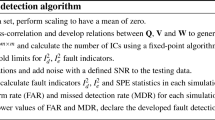Abstract
This paper presents a comparison of methods for industrial on-line sensor calibration monitoring for redundant sensors. Principal component analysis (PCA) and independent component analysis (ICA) techniques are developed and compared using both simulated data and data sets from an operating nuclear power plant. The performance is dependent on the types of noise sources; however, under most conditions ICA outperforms PCA, based on the bias and variance of their respective parameter estimates. A case study is included to demonstrate the usefulness of both techniques for the early detection of sensor drift.
Similar content being viewed by others
References
Amand, Th., Heyen, G., and Kalitventzeff, B. 2001. Plant monitoring and fault detection synergy between data reconciliation and principal component analysis. Computers and Chemical Engineering 25: 501-507.
Cardoso, J.-F. 1992. Iterative techniques for blind source separation using only fourth-order cumulants. In Proceedings of EUSIPCO. Brussels, Belgium, pp. 739-742.
Cichocki, A., Amari, S., Siwek, K. et al. 2002. ICALAB Toolboxes. http://www.bsp.brain.riken.go.jp/ICALAB.
Comon, P. 1994. Independent component analysis-a new concept? Signal Processing 36: 287-314.
Comon, P., Jutten, C., and Herault, J. 1991. Blind separation of sources, part 2: problems statement. Signal Processing 24(1): 11-20.
Davis, E., and Funk, D. L. 1995. Monte Carlo simulation and uncertainty analysis of the instrument calibration and monitoring program. EPRI WO3785-02.
Davis, E., Funk, D., Hooten, D., and Rusaw, R. 1998. On-line monitoring of instrument channel performance. EPRI TR-104965.
Doymaz, F., Romagtnoli, J. A., and Palazoglu, A. 2001a. A strategy for detection and isolation of sensor failures and process upsets. Chemometrics and Intelligent Laboratory Systems 55: 109-123.
Doymaz, F., Chen, J., Romagtnoli, J. A., and Palazoglu, A. 2001b. A robust strategy for real-time process monitoring. Journal of Process Control 11: 343-359.
Dunia, R., and Qin, S. J. 1998. A unified geometric approach to process and sensor fault identification and reconstruction: the unidimensional fault case. Computers and Chemical Engineering 22(7–8): 927-943.
Dunia, R., Qin, S. J., Edgar, T. F., and McAvoy, T. J. 1996. Identification of faulty sensors using principal component analysis. AIChE Journal 42(10): 2797-2811.
Giannakopoulos, X., Karhunen, J., and Oja, E. 1999. Experimental comparison of neural algorithms for independent component analysis and blind separation. International Journal of Neural Systems 9(2): 651-656.
Gross, K. S., and Humenik, K. E. 1991. Sequential probability ratio test for nuclear plant component surveillance. Nuclear Technology 93: 131-137.
Hastie, T., Tibshirani, R., and Friedman, J. 2002. The Elements of Statistical Learning, Data Mining, Inference and Prediction. New York: Springer-Verlag.
Hotelling, H. 1933. Analysis of a complex of statistical variables into principal components. Journal of Educational Psychology 24: 417-441, 498–520.
Hyvarinen, A. 1999. Fast and robust fixed-point algorithms for independent component analysis. IEEE Transactions on Neural Networks 10(3).
Hyvarinen, A., Karhunen, J., and Oja, E. 2001. Independent Component Analysis 1-11, 125–137.
Joliffe, I. T. 1986. Principal Component Analysis. New York: Springer-Verlag.
Jutten, C., and Herault, J. 1991. Blind separation of sources, part 1: an adaptive algorithm based on neuromimetic architecture. Signal Processing 24(1): 1-10.
Kano, M., Nagao, K., Hasebe, S., Hashimoto, I., Ohno, H., Strauss, R., and Bakshi, B. 2000. Comparison of statistical process monitoring methods: application to the Eastman challenge problem. Computers and Chemical Engineering 24: 175-181.
Kano, M., Hasebe, S., Hashimoto, I., and Ohno, H. 2001. A new multivariate statistical process monitoring method using principal component analysis. Computers and Chemical Engineering 25: 1103-1113.
Marbach, R., and Heise, H. M. 1990. Calibration modeling by partial least-squares and principal component regression and its optimization using an improved leverage correction for prediction testing. Chemometrics and Intelligent Laboratory Systems 9: 45-63.
Martens, H., and Naes, T. 1989. Multivariate Calibration. Chichester: John Wiley & Sons.
MATLAB. 1999. High performance numeric computation and visualization software, v.5.3. The Mathworks, Inc., Natick, MA.
NRC Letter dated June 22, 2000, Safety Evaluation related to Topical Report (TR) 104965, On-Line Monitoring of Instrument Channel Performance.
Pearson, K. 1901. On lines and planes of closest fit to systems of points in space. Philosophical Magazine 2(6): 559-572.
Ray, A., and Phoha, S. 2000. Calibration and estimation of redundant signals. Automatica 36: 1525-1534.
Sanchez, A., and David, V. 2002. Frontiers of research in BSS/ICA. Neurocomputing 49: 7-23.
Seiter, J. C., and DeGrandpre, M. D. 2001. Redundant chemical sensors for calibration-impossible applications. Talanta 54: 99-106.
Vigneau, G., and Qannari, E. M. 2002. A new algorithm for latent root regression analysis. Computational Statistics and Data Analysis 41: 231-242.
Wald, A. 1947. Sequential Analysis. New York: Wiley.
Wise, B. M., Gallagher, N. B., Butler, S. W., White, D., and Barna, G. G. 1997. Development and benchmarking of multivariate statistical process control tools for a semiconductor etch process: impact of measurement selection and data treatment on sensitivity. In IFAC SAFEPROCESS'97. Kingston Upon Hull, U.K., August, pp. 35-42.
Wooten, B. 1993. Instrument calibration and monitoring program volume 1: basis for the method. EPRI TR-103436-V1.
Author information
Authors and Affiliations
Rights and permissions
About this article
Cite this article
Ding, J., Gribok, A.V., Hines, J.W. et al. Redundant Sensor Calibration Monitoring Using Independent Component Analysis and Principal Component Analysis. Real-Time Systems 27, 27–47 (2004). https://doi.org/10.1023/B:TIME.0000019125.96107.ac
Issue Date:
DOI: https://doi.org/10.1023/B:TIME.0000019125.96107.ac




